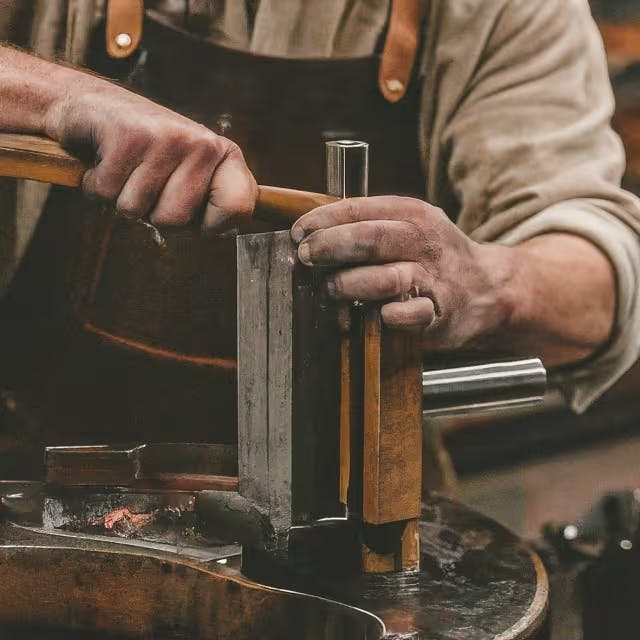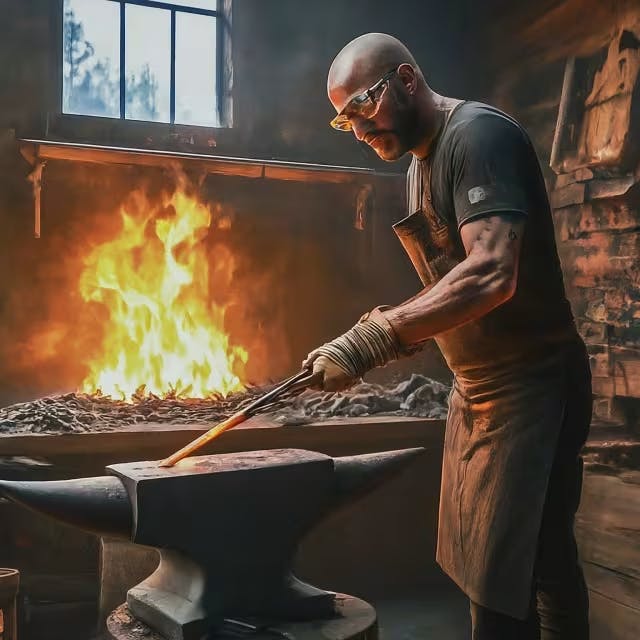Swage Blocks: Multiple Uses in Metalworking
Abana Chapter
March 03, 2024

Swage blocks, a cornerstone of the metalworking world, boast a rich history and diverse functionality that make them indispensable tools for anyone involved in metal shaping. Crafted from resilient materials like cast iron or steel, these blocks are engineered with a variety of holes, forms, and scalloped edges. Their versatility allows for a wide array of metalworking tasks, from bending and cutting to more intricate forging operations, catering to both industrial applications and artistic endeavors. As we explore the vast landscape of swage blocks' multiple uses in metalworking, we uncover how these tools not only support traditional smithing techniques but also empower artists and craftsmen to push the boundaries of metal sculpture and design.
Key Takeaways
Swage blocks are vital tools in metalworking due to their resilient materials like cast iron or steel, and their diverse designs featuring holes, forms, and scalloped edges.
They offer unparalleled versatility, facilitating a wide range of metalworking tasks from bending and cutting to intricate forging.
Their utility extends beyond industrial applications, also supporting artistic endeavors in metal sculpture and design.
Swage blocks serve as essential instruments for shaping metal, enabling both traditional smithing techniques and innovative approaches in metalworking.
The use of swage blocks in metal forming provides distinct benefits, including efficiency and the ability to achieve complex shapes.
Their versatility underpins the craft of blacksmithing and metal sculpting, making them indispensable for craftsmen aiming to push the boundaries of what can be achieved in metalwork.
What is a Swage Block? Understanding Its Role in Metalworking
A swage block is not your average tool; it's the Swiss Army knife of the metalworking world. Cast from heavy-duty materials like iron or steel, it presents a labyrinth of holes, slots, and contours eagerly awaiting to transform hot metal bars into masterpieces. Picture a block punctuated with semi-circular, square, and hexagonal spaces around its edges. Each of these shapes plays a unique role, aligning with top swages to meticulously forge metal bars into the desired cross-sections.
For those diving into the realms of industrial or artistic metalworking, swage blocks offer an indispensable utility for a multitude of operations. From bending and cutting to punching and forming, these tools stand at the ready. Particularly in artistic metalworking, swage blocks feature unique forms allowing for the creation of intricate and detailed metal objects. Their versatility and functionality enrich the artistry of metalwork, opening doors to innovative designs and creations.
Discover more about the multifaceted roles of these tools in the metalworking process here. Whether you're a seasoned smith or an aspiring craftsman, understanding how to harness the capabilities of a swage block can transform the way you work with metal, turning ordinary materials into extraordinary pieces of art.
Swage Blocks: Essential Tools for Shaping Metal
Swage blocks stand out as multifaceted heroes in the realm of metalworking, offering a variety of functions that are indispensable for professionals and hobbyists alike. These robust tools, crafted from durable materials like cast iron or steel, are designed with an array of holes, forms, and scalloped sides. This unique design supports a wide range of metalworking tasks such as bending, cutting, punching, and shaping hot metal bars into desired forms. The versatility of swage blocks extends to two main types: industrial and artistic. Industrial swage blocks cater to standard shaping needs, while their artistic counterparts are tailored for more creative endeavors. They contain specialized features for sculpting unique items like spoons, ladles, and funnels, proving invaluable for projects that require a touch of finesse or unconventional shapes. Discover more about these indispensable tools and their applications in metalworking by exploring the detailed overview provided here.
Exploring the Various Applications of Swage Blocks
Swage blocks are incredibly versatile tools in metalworking, catering to both professionals and hobbyists alike. These hefty, durable blocks are not just for shaping metals; their grooves and holes allow for a multitude of applications. For instance, they are indispensable in creating customized gouges for violin making, where precision and the ability to work with various materials are key. Similarly, artists attending workshops at places like Studio Workshops can leverage swage blocks for specialized tasks in sculpting and functional art creation, pushing the boundaries of traditional and contemporary craftsmanship. Their multifunctionality can spark creativity, offering pathways to explore new techniques and mediums.
The Benefits of Using Swage Blocks in Metal Forming
Swage blocks stand as a cornerstone in the world of metalworking, offering versatility and precision that are unmatched in shaping metals. Unique in design and function, these tools serve a wide array of purposes, from bending and forming to cutting and punching. With a variety of shapes and sizes engraved into their hardy surfaces, swage blocks allow for the creation of complex metal shapes and forms with ease.
One of the benefits of swage blocks is their ability to support both hot and cold forging processes. This dual capability ensures that they can be seamlessly integrated into various stages of the metalworking process, making them indispensable for craftsmen and fabricators alike. For more detailed insight into the world of metal shaping, exploring topics like swages and fullers can expand your understanding and appreciation of these techniques.
Metalworkers often resort to swage blocks when working with precious metals, as the process minimizes material loss. This efficiency is crucial in industries where every gram of material counts, such as jewelry making. The controlled deformation of metal allows for intricate detailing and precise fittings, like embedding bearings into housings—a process described in detail through the cold and hot forging methods discussed in swaging techniques.
One cannot overstate the importance of having the right tools for any job. For those delving deeper into the world of metal forming, discovering must-have anvil accessories, including swage blocks, provides a solid foundation for efficient and safe metalworking endeavors.
Ultimately, swage blocks embody the essence of craftmanship in metalworking—precision, efficiency, and versatility. Their use not only simplifies complex metal forming tasks but also enriches the repertoire of skills and techniques at the disposal of artisans and professionals.

Swage Blocks: Versatility in Blacksmithing and Metal Sculpting
Swage blocks stand out as indispensable tools in the realm of metalworking, demonstrating unmatched versatility and operational breadth. Their ability to accommodate various metal shaping, bending, and punching tasks makes them essential for both the seasoned professionals and enthusiastic hobbyists. As such, swage blocks not only facilitate the exploration of artistic metalwork but also enhance the efficiency and quality of industrial metal forming processes.
Frequently Asked Questions
What are the unique features of swage blocks that make them indispensable in metalworking?
Swage blocks are indispensable in metalworking due to their versatility in handling a multitude of tasks like bending, cutting, punching, and shaping metals. Their robust design, featuring an array of holes, forms, and scalloped sides, accommodates both hot and cold forging processes. This functionality is essential for crafting intricate metal shapes and minimizing material loss in industries such as jewelry making. The distinction between industrial and artistic swage blocks further underscores their utility in creating both standard and highly specialized metal objects, making them a cornerstone tool in metalworking.
How do swage blocks facilitate the creation of intricate metal objects in artistic metalworking?
Swage blocks serve as versatile tools in artistic metalworking due to their unique design featuring a variety of shapes and contours. These features allow for the precise shaping, bending, and forming of metal into intricate objects, enabling artists to create detailed and complex designs. The versatility and functionality of swage blocks open doors to innovative creations in metal art, making them indispensable for those looking to explore new techniques and designs in their work.
In what ways do industrial and artistic swage blocks differ, and how does this impact their use?
Industrial swage blocks are designed for standard metal shaping tasks with a focus on efficiency and precision, supporting operations like bending, cutting, and forming. Artistic swage blocks, however, feature unique shapes and contours tailored for creating intricate and detailed metal objects, catering to creative and unconventional projects. This specialization impacts their use by offering artists the ability to explore innovative designs and push the boundaries of traditional metalworking, while industrial blocks streamline and standardize the fabrication process for professional efficiency.
Why are swage blocks considered vital for minimizing material loss, especially in precious metal work?
Swage blocks are considered vital for minimizing material loss in precious metal work because they allow for precise shaping and forming with minimal waste. Their variety of holes, slots, and contours enable metalworkers to efficiently craft intricate designs and fine details without excess cutting or removal of material. This is especially crucial in fields like jewelry making, where conserving valuable materials is key to both artistry and cost management.
How do swage blocks support both hot and cold forging processes in metal shaping?
Swage blocks support both hot and cold forging processes through their unique design, featuring various shapes and sizes that are ideal for bending, forming, cutting, and punching metal. Whether working with hot or cold metals, these tools offer unparalleled versatility, making them indispensable for craftsmen and fabricators. Their ability to handle different temperatures and metal types seamlessly integrates into the metalworking process, enhancing both precision and efficiency.


